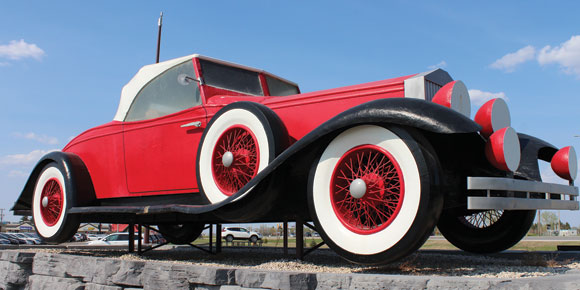Mention the name Steinbach and for many people the tag line “The Automobile City” will come to mind.
A. D. Penner, a Chrysler Dodge dealer known for his quirky promotions and comical highway signs meant to lure people into town and his dealership is credited with coining the term. He began using it in 1956 after the grand reopening of his expanded dealership and by 1958 other dealerships, and even local businesses not related to the automobile industry, included it in their advertising.
The accompanying phrase, “It’s worth the trip” first appeared in the mid-1980s in print ads and as a jingle in radio and TV commercials.
Big Red Car (1991)
Highway 12 at Park Road West
Steinbach’s town statue is modelled on a 1931 Rolls Royce Phantom and was constructed in 1991 by John Henry Friesen using wood and fibreglass at a cost of $36,000.
Most Manitobans are familiar with Friesen’s work though probably don’t know it. His company has built parade floats that are seen around the province, including a number that appear in Winnipeg’s Santa Claus parade. He also built Santa’s castle for the Polo Park mall in 2000 and regilded the Golden Boy in 2002.
The 16.7-metre long roadster was on display for over two decades at the Clearspring Centre mall parking lot until it had to be moved to make way for a new development in 2012.
The car then underwent extensive renovations that included replacing the fibreglass and parts of the frame plus a new paint job. At its new home, a raised stone base was built for the car to sit on. The estimated $70,000 cost of the work was covered by the Steinbach Automobile Dealership Association.
It is appropriate that a car should be the city’s statue as the automobile has long been part of its history.
The first automobile arrived in Steinbach in 1911. It was a Ford owned by local businessman J. R. Friesen. Not everyone in the conservative, religious town shared his appreciation for such modern inventions. It is said that he was excommunicated from his church because of it.
This didn’t dampen Friesen’s passion for automobiles. In fact, in 1914 he opened the town’s first new car dealership. (That dealership, once known as J.R Friesen & Sons, still operates to this day under the name Fairway Ford.)
Other entrepreneurs joined Friesen in the car business with other new dealerships, used car lots or repair shops. By the 1950s, the city had as wide a selection of automobile-related businesses as communities many times its size.
More than a century after Friesen opened its first dealership, Steinbach boasts six new car dealerships employing nearly 300 people.
Millennium Clock Tower (2002)
Main Street at Reimer Avenue
Plans to construct a clock tower in the heart of Steinbach’s business district were announced in January 1999 by a committee headed by developer David Banman.
In October, the project received a grant from the federal government’s Millenium Partnership Program of $87,000 toward its estimated $300,000 final cost.
The site chosen was out front of the Towne Square strip mall where a clock tower on a smaller scale was to have been part of the mall’s original design when it was built a decade earlier.
The three-storey tower was designed by local commercial designer Ron Schalla. The traditional look and use of red brick with Tyndall stone accents were meant to pay tribute to the old town office that once stood across the street.
On August 1, 2001, the steel frame, manufactured in Blumenort, was lifted into place and a dedication ceremony held the next afternoon. In October, the roof and a bell housing was added and from March to May 2002, mason John Klassen laid the brick and stone.
The original plans for the tower were to include not only a clock, but also a large, brass bell. The bell idea was scrapped in the end.
The clock was officially unveiled in the summer of 2002.
Steinbach Cenotaph (1956)
Main Street at Reimer Avenue
In 1954, the Steinbach branch of the Royal Canadian Legion began raising funds for a cenotaph dedicated to the men and women of the region who served in the two World Wars and Korea.
The federal government agreed to donate a corner of the post office’s lot as the location of the memorial. Mr. Lowen of Lon’s Stoneworks was approached to provide a design and a quote.
The Legion spent the next year fundraising for the project. Donations came from the town council, R. M. of Hanover, the Hotelkeepers and Brewers Wartime Fund, (which was originally set up to collect money to purchase a spitfire plane for the war effort), the Steinbach Women’s Institute and many others.
The cenotaph was dedicated on Sunday, September 16, 1956. Presiding over the ceremony was Duff Roblin, Manitoba’s premier and Vice President of the regional command of the Legion, Peter Thiessen, head of Steinbach’s legion branch, and Mrs. D. J. MacIntosh, president of the Legion’s auxilliary.
The unveiling of the cenotaph invovled a parade down main street that included the colours of numerous Manitoba Legion branches, thirty members of the local Legion and the fifty-member Warroad High School Band.
The Steinbach Carillon newpspaer called the event “a spectacle never before wintessed in Steinbach”.
Christian writes about local history at his blog, West End Dumplings.



